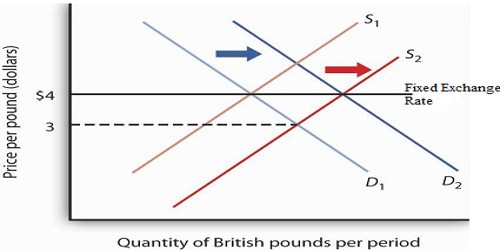The fixed exchange rate is the rate which is officially fixed by the government or monetary authority and not determined by market forces. Only a very small deviation from this fixed value is possible. It is a system of currency exchange in which the value of one currency is tied to another. In this system, foreign central banks stand ready to buy and sell their currencies at a fixed price. A typical kind of system was used under the Gold Standard System in which each country committed itself to convert freely its currency into gold at a fixed price. The purpose of a fixed exchange rate system is to keep a currency’s value within a narrow band.
A fixed exchange rate is the rate which is officially fixed in terms of gold or any other currency by the government. Fixed rates also help the government preserve low inflation, which, in the long run, keep the interest rates down and stimulates trade and investment. It does not change with a change in demand and supply of foreign currency. In other words, the value of each currency was defined in terms of gold and, therefore, the exchange rate was fixed according to the gold value of currencies that have to be exchanged. This was called the minimum par value of exchange. Later on, Fixed Exchange Rate System prevailed in the world under an agreement reached in July 1994. Often countries join a semi-fixed exchange rate, where the currency can alter within a little target level. For example, the European Exchange Rate Mechanism ERM was a semi-fixed exchange rate system.
The advantages and disadvantages of this system are as under:
Merits:
- It ensures stability in the exchange rate which encourages foreign trade, it provides greater certainty for importers and exporters, therefore encouraging more international trade and investment.
- It contributes to the coordination of macro policies of countries in an interdependent world economy,
- Fixed exchange rate ensures that major economic disturbances in the member countries do not occur, a rapid appreciation in the exchange rate will badly effect manufacturing firms who export; this may also cause a worsening of the current account.
- It prevents capital outflow and helps the government maintain low inflation, which can have positive long-term effects such as keeping down interest rates.
- Fixed exchange rates are more conducive to the expansion of world trade because it prevents risk and uncertainty in transactions,
- It prevents speculation in the foreign exchange market. If the value of currencies fluctuates, significantly this can cause problems for firms engaged in trade.
Demerits:
(a) Fear of devaluation. In a situation of excess demand, the central bank uses its reserves to maintain foreign exchange rate. But when reserves are exhausted and excess demand still persists, the government is compelled to devalue the domestic currency. If speculators believe that the exchange rate cannot be held for long, they buy, foreign exchange in a massive amount causing a deficit in the balance of payment. This may lead to larger devaluation. This is the main flaw or demerit of the fixed exchange rate system,
(b) Less flexibility. In a fixed exchange rate, it is complicated to react to momentary shocks. For example, if the price of oil increases, a country which is a net oil importer will see deterioration in the current account balance of payments.
(c) Benefits of free markets are deprived;
(d) There is always a possibility of under-valuation or over-valuation.
(e) Preventing adjustments for currencies that become under or overvalued.
(f) Limiting the extent to which central banks can adjust interest rates for economic growth.
(g) Requiring a large pool of reserves to support the currency if it comes under pressure.














